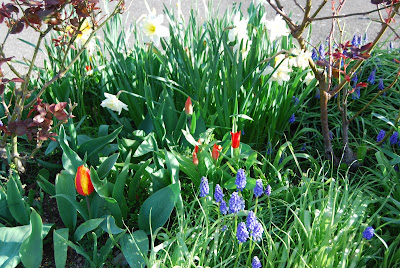 |
| Gardening jobs for October |
It may be coming to the end of the growing season but there is plenty of work to be done in tidying up the garden and preparing your plant stock for the onset of winter. There are spring flowering bulbs that will need to be planted as soon as they become available in the shop as well as lifting any plants that need to be overwintered in a protected environment.
So any jobs that can be done now before the winter weather sets in has got to make life easier. So check out below my top gardening jobs for October.
1. Plant spring flowering bulbs – these will need the cold period of winter to initiate flowering. Don’t leave it too late to plant pre-packed and loose bulbs as these can dry out if left too long in warm shop conditions.
.
For further information click onto:
.
2. Lift and store dahlias in a frost free environment when their foliage has been blackened by the first of the winter frosts. In mild winters and in particular for gardens with a free draining soil you may be able to get away with protecting them with a heavy dry mulch such as bark chips of gravel. This can also work for fibrous begonias, but there can still be a risk from cold damage if temperatures drop to low.
.
For further information click onto:
.
3. It takes two years in our English climate for the fruit from a fig tree to properly grow and ripen. In order to successfully overwinter this year's embryonic fruit, they will need protecting from the worst of the cold. In sheltered positions, securing waxy brown paper bags of the fruit is often enough to do the trick, however in a more exposed positions you may need to cover with plastic netting, and back then filling it with a loose layer of straw or bracken.
4. Bring new life to your rhubarb next year by lifting, dividing and replanting your old crowns. Try and disturb the roots as little as possible and mix in a good quality slow-release fertilizer in the hole before you replant.
5. Now is the time to spray peaches and nectarines against peach leaf curl - just as the leaves begin to drop. When they do, collect and burn them to help prevent further infections next spring. For the more adventurous, try covering your trees with polythene supported by wooden posts. This will help to protect them against freezing winter temperatures as well as prevent reinfection next year from spores carried in rain droplets.
For related articles click onto the following links:
GARDENING JOBS FOR JANUARY
GARDENING JOBS FOR FEBRUARY
GARDENING JOBS FOR APRIL
Which Gardening Jobs for October
Gardening Jobs for November
4. Bring new life to your rhubarb next year by lifting, dividing and replanting your old crowns. Try and disturb the roots as little as possible and mix in a good quality slow-release fertilizer in the hole before you replant.
5. Now is the time to spray peaches and nectarines against peach leaf curl - just as the leaves begin to drop. When they do, collect and burn them to help prevent further infections next spring. For the more adventurous, try covering your trees with polythene supported by wooden posts. This will help to protect them against freezing winter temperatures as well as prevent reinfection next year from spores carried in rain droplets.
GARDENING JOBS FOR JANUARY
GARDENING JOBS FOR FEBRUARY
GARDENING JOBS FOR APRIL
Which Gardening Jobs for October
Gardening Jobs for November
.









